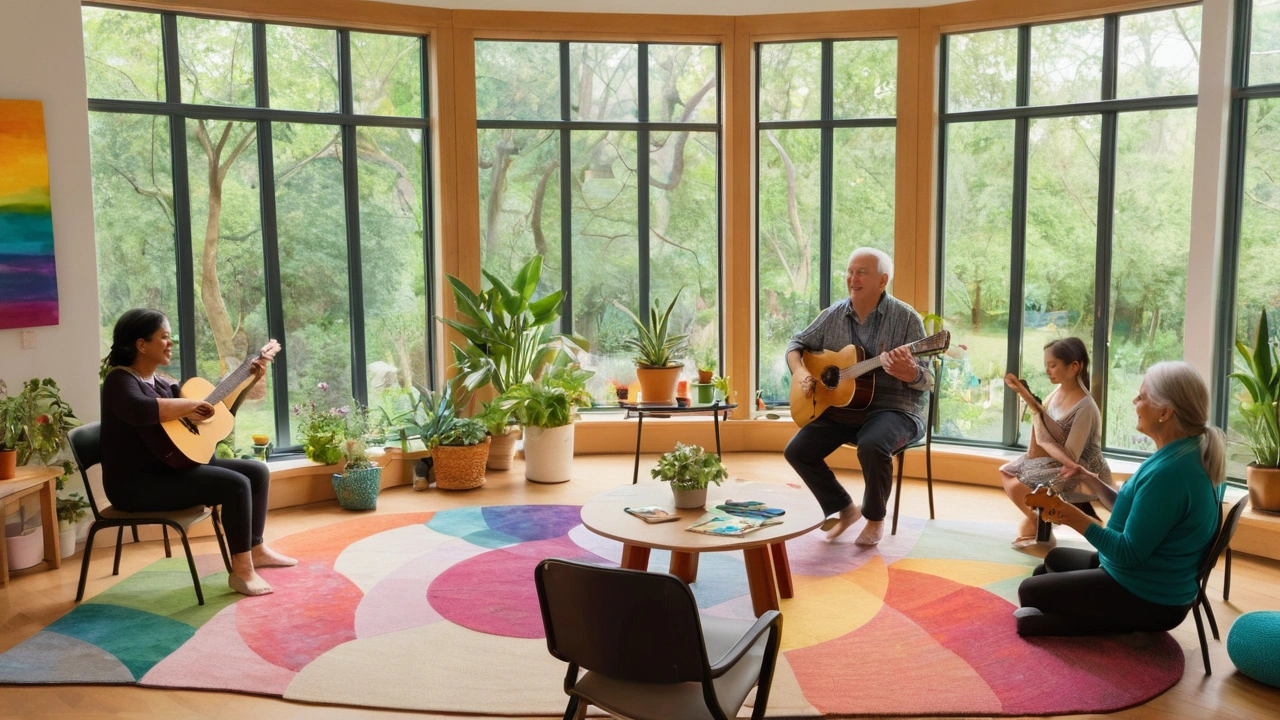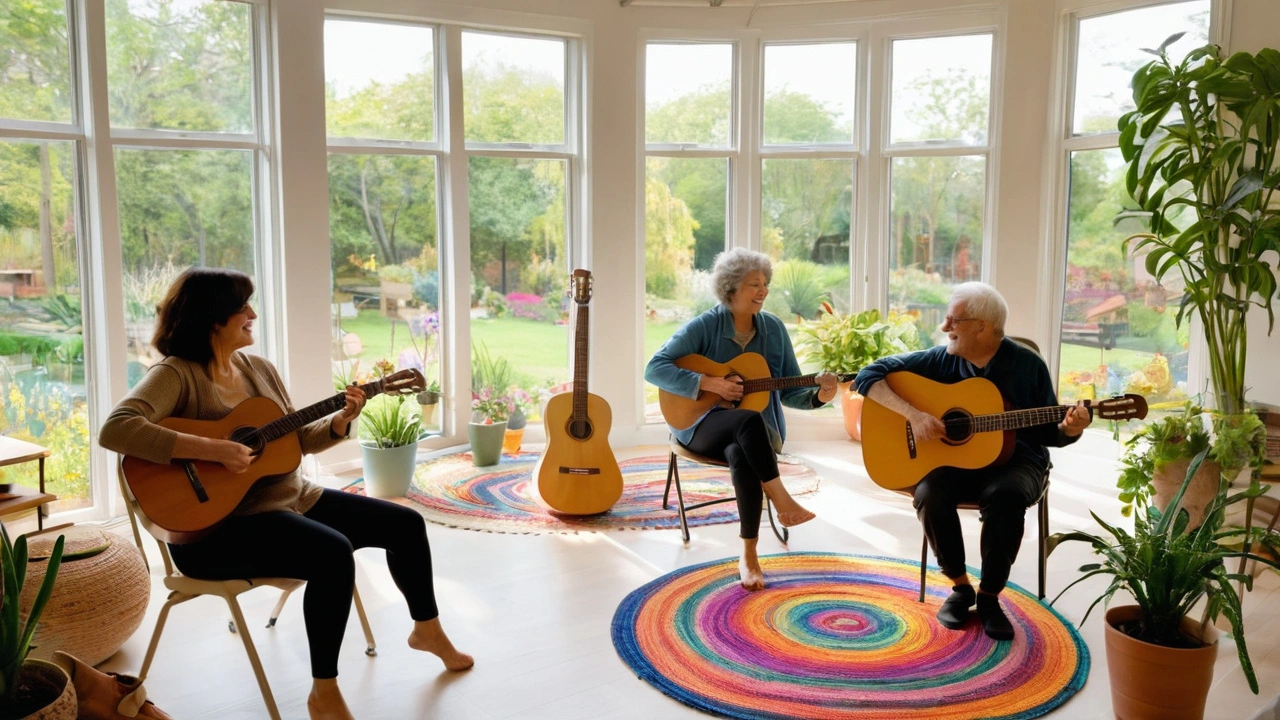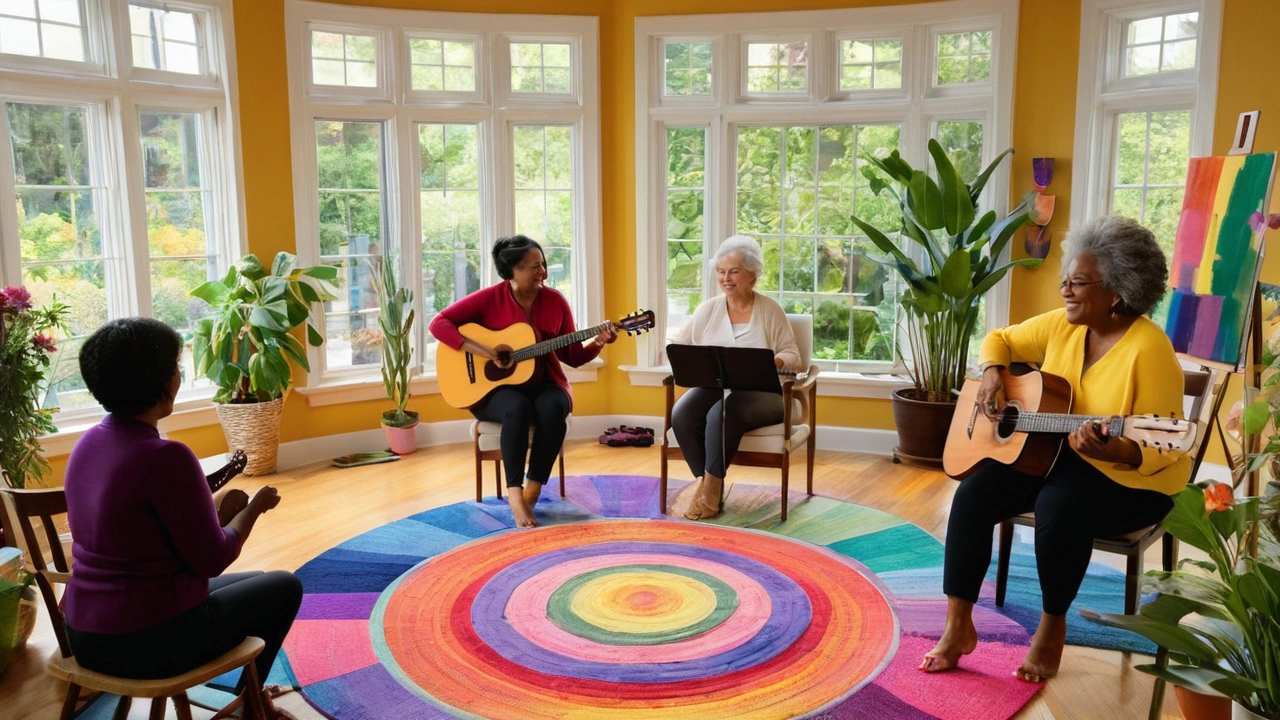Creative arts therapies have been gaining recognition for their remarkable impact on mental and emotional well-being. These therapies include a variety of techniques that use creative expression to promote healing and personal development. Whether it's painting, dancing, or acting, each modality offers unique ways to address emotional pain, trauma, and other mental health challenges.
In this guide, we will delve into the different forms of creative arts therapies, uncovering their benefits and how they can make a difference in one's life. You'll find practical advice on how to choose the right therapy for your specific needs and numerous success stories that highlight their effectiveness.
- Introduction to Creative Arts Therapies
- Benefits of Art Therapy
- Exploring Music Therapy
- Movement and Dance Therapy
- Drama and Role Play
- Choosing the Right Therapy
Introduction to Creative Arts Therapies
Creative arts therapies encompass several therapeutic approaches that use different forms of art to improve psychological health. These therapies have roots in ancient times when humans first used artistic expressions in healing rituals. Today, creative arts therapies - including art therapy, music therapy, dance/movement therapy, and drama therapy - are backed by scientific research and applied in diverse settings, from hospitals to schools.
The core idea behind these therapies is that creative expression helps people express emotions that they might find difficult to put into words. Through engaging in art, music, movement, or drama, individuals can explore their thoughts and feelings in a safe and non-judgmental environment. This is particularly beneficial for those who have experienced trauma or are dealing with mental health issues such as depression and anxiety.
Art therapy, for instance, uses drawing, painting, and sculpture to help people explore their emotions, develop self-awareness, and cope with stress. According to the American Art Therapy Association, this form of therapy can foster healing by integrating mental and physical processes. Similarly, in music therapy, listening to or creating music encourages emotional release and can help alleviate symptoms of various mental health conditions.
“Music can change the world because it can change people,” said Bono, illustrating the transformative power of music therapy.
With dance/movement therapy, participants use body movement to express themselves, which can lead to significant psychological and physical benefits. This therapy is based on the knowledge that the body and mind are interconnected, and movement can provide a means of communication and expression. Drama therapy, on the other hand, often involves role-play and storytelling, allowing people to work through difficult situations and emotions by acting them out in a supportive setting.
Studies have shown that creative arts therapies can lead to reductions in anxiety, increases in mood and self-esteem, and improved social functioning. These therapies are adaptable and can be used with individuals of all ages and abilities. For instance, children with autism often engage in creative arts therapies to enhance communication and social skills, while senior citizens might use these therapies to maintain cognitive function and connectivity.
Given their versatility and effectiveness, it’s no surprise that creative arts therapies are becoming increasingly popular. They offer an alternative or complementary treatment to traditional talk therapy, providing a holistic approach to mental health care. As more research emerges, the potential applications of these therapies are expected to expand even further, helping countless people to heal and thrive.
Benefits of Art Therapy
Art therapy is a powerful tool that blends the creative process with psychotherapy to help individuals express themselves, explore emotions, and solve problems. Utilizing mediums such as drawing, painting, and sculpting, art therapy provides a non-verbal way for people to communicate complex feelings when words fail. One of the most significant benefits of art therapy is its ability to foster emotional release and self-discovery. This therapeutic approach can be especially beneficial for those who have experienced trauma or who suffer from anxiety and depression.
One interesting aspect of art therapy is its ability to engage the brain's right hemisphere, which is responsible for creativity and visual-spatial abilities. Research has shown that engaging in art-making activities can reduce levels of cortisol, the body's stress hormone. This physiological impact makes art therapy an effective tool for stress management. Another noteworthy benefit is the enhancement of cognitive function. For older adults, engaging in art therapy can help maintain cognitive health and delay the onset of dementia.
As noted by the American Art Therapy Association, "Art therapy provides individuals with a natural and accessible avenue for emotional expression and can be particularly helpful for those who find it challenging to communicate verbally."Through repeated sessions, participants learn to use art as a coping mechanism, developing a stronger sense of self and better emotional regulation. Additionally, creating art can instill a sense of accomplishment, boosting self-esteem and promoting feelings of autonomy. This sense of achievement is vital for individuals struggling with low self-worth or self-doubt. Another significant aspect is the development of problem-solving skills through the artistic process. When faced with difficulties in their creative projects, individuals learn to adapt and find solutions, which can transfer to everyday life challenges.
Promoting Social Interaction
Group art therapy sessions are particularly effective at fostering social connections and building community among participants. These sessions encourage individuals to share their creations and experiences, which can lead to meaningful conversations and a shared sense of empathy. This collective experience can help reduce feelings of isolation, especially for those who suffer from social anxiety or have trouble forming relationships. It's also worth mentioning that witnessing others' creative expressions can inspire and motivate participants, further enriching the therapeutic experience. Moreover, structured group activities can help improve communication skills and teamwork abilities, which are essential for personal and professional growth.
Encouraging Mindfulness
Art therapy also promotes mindfulness, a practice that involves being fully present and engaged in the moment. The act of creating art requires concentration and can serve as a form of meditation, helping individuals to stay focused and grounded. This mindfulness aspect can significantly reduce symptoms of anxiety and depression. Many art therapists incorporate mindfulness techniques into their sessions, such as guiding clients through a focused drawing or painting task and encouraging them to observe their thoughts and feelings without judgment. This practice can enhance self-awareness and create a greater sense of peace and calm, making it a valuable tool for managing mental health.
In summary, the benefits of art therapy are vast and varied, impacting emotional, cognitive, and social well-being. By providing a creative outlet for expression and problem-solving, art therapy empowers individuals to explore their inner worlds, build resilience, and connect with others. Whether you're an artist or someone seeking a new way to address life's challenges, art therapy offers a unique and accessible path to healing and personal growth.

Exploring Music Therapy
Music therapy involves the clinical and evidence-based use of music interventions to accomplish individualized goals within a therapeutic relationship. It is a compelling pathway to healing, tapping into sound and rhythm to facilitate emotional expression, enhance memory, and foster both cognitive and physical development. This type of therapy is suitable for all age groups and can address a wide range of health issues, including mental health disorders, developmental and learning disabilities, Alzheimer's disease, and chronic pain.
Music therapy isn't just about listening to music; it encompasses creating, singing, moving to, and/or listening to music. It can elicit emotional responses to help relax or stimulate patients or provide a form of communication for those who find it difficult to express themselves in words. Many patients attest to feeling a significant reduction in stress and anxiety after sessions. In fact, a study published in the Journal of Advanced Nursing found that music therapy significantly reduced anxiety in patients undergoing chemotherapy and radiation therapy.
One of the promising aspects of music therapy is its versatility. For instance, someone with motor skill issues might engage in rhythmic movements to enhance coordination, while an individual with memory loss might benefit from familiar songs that evoke strong memories. Music therapy can also be highly effective in a group setting where participants share and create musical experiences together, creating a sense of community and shared purpose.
Many therapists employ various instruments such as drums, keyboards, and guitars depending on the patient's needs and preferences. The music therapist will assess the patient's abilities and tailor activities to meet therapeutic goals. Techniques may include improvisation, songwriting, lyric discussion, or even guided imagery. The objective is to use these tools to help patients work through emotional conflicts, improve social skills, and increase self-awareness.
A poignant fact about music therapy is that it has roots extending back to ancient times. Historical records indicate that music has been used in healing rituals for centuries. Today, it's recognized as a distinct clinical discipline with a growing body of research to support its efficacy. Notably, the American Music Therapy Association reports that hospitalized children who receive music therapy require less sedation and experience shorter hospital stays compared to those who do not.
"Music can change the world because it can change people." - Bono, U2
Music therapy sessions are typically conducted by a certified music therapist who has completed specific educational and clinical training. This professional collaborates closely with the patient's healthcare team to ensure the therapy aligns with medical and therapeutic goals. Sessions can be personalized to focus on particular issues, such as stress relief, pain management, or cognitive function enhancement, offering a customized therapeutic experience.
For those curious about incorporating music therapy into their lives, it’s essential to seek out a licensed practitioner who adheres to the highest ethical standards. Recognizing the benefits and varied approaches of music therapy can empower individuals to make informed decisions about their mental health and well-being. By harmonizing the mind and body through the power of music, this form of therapy proves an invaluable tool in the tapestry of holistic healing practices.
Movement and Dance Therapy
Movement and dance therapy is a fascinating form of creative arts therapy that combines the elements of dance and movement to promote physical, emotional, and mental well-being. This therapeutic approach is based on the idea that the body and mind are interconnected, and movement can help release emotional blockages, reduce stress, and improve overall health. It's not just about structured dance routines; it’s also about freeform movement that comes from the heart and soul.
One of the most significant benefits of movement and dance therapy is its ability to help people express emotions they might find difficult to articulate with words. This can be incredibly liberating and healing, especially for those who have experienced trauma or are struggling with mental health issues such as anxiety and depression. By engaging in movement, individuals can access and process buried emotions in a safe and supportive environment.
Another important aspect of movement and dance therapy is its influence on the body. Engaging in regular movement therapy sessions can improve physical health by enhancing flexibility, coordination, and balance. It can also be a great cardiovascular workout, helping to boost mood and energy levels through the release of endorphins. For these reasons, movement and dance therapy is often used as a complementary treatment for various health conditions, including chronic pain and fatigue.
Research has shown that dance therapy can be particularly effective in improving the quality of life for individuals with chronic illnesses. A study published in the “Journal of American Medical Association” found that participants who engaged in movement and dance therapy reported significant improvements in their emotional and social well-being. This suggests that the physical activity combined with creative expression can have a meaningful impact on an individual's overall health.
Children and adolescents can also benefit greatly from movement and dance therapy. For young people who may have difficulty expressing themselves verbally or who are dealing with behavioral issues, this form of therapy can provide a positive outlet for their emotions and energy. It can help them develop social skills, build self-confidence, and improve their ability to focus and concentrate.
“Dance is the hidden language of the soul,” said Martha Graham, a pioneer of modern dance. Her words resonate with the core principles of movement and dance therapy, where expression through movement reveals deeper emotional truths.
To get started with movement and dance therapy, it’s helpful to find a qualified therapist who specializes in this field. Sessions often begin with a warm-up period followed by guided activities that encourage self-exploration and creative movement. Over time, participants learn to trust their bodies and the therapeutic process, which can lead to profound personal growth and healing.

Drama and Role Play
Drama therapy uses acting, storytelling, and role-playing to help individuals express themselves and explore their emotional experiences in a safe environment. This type of therapy allows people to step into different roles, which can provide new perspectives and insights. It's particularly useful for those who find it difficult to talk about their feelings directly. Drama therapy has been used to treat a range of issues, including anxiety, depression, PTSD, and even relationship problems.
One of the significant benefits of drama therapy is its ability to create a comfortable space for people to open up about their emotions. By engaging in role play, individuals can process complex feelings and experiences without the pressure of discussing them explicitly. This approach can be especially effective for children and teenagers, who might find it challenging to articulate their emotions.
During a typical session, a trained therapist might ask participants to reenact scenes from their lives or to create fictional scenarios. This can help identify underlying issues and facilitate discussion about deep-seated emotions. The therapist will guide the session to ensure it remains therapeutic and not stressful for the participants. Some sessions may involve group activities, where participants interact and support each other, adding to the healing process.
A fascinating aspect of drama therapy is its use of masks, puppets, and costumes. These tools can help clients project their emotions onto an external object, making it easier to discuss difficult topics. Acting out scenes with these props can also foster creativity and provide a sense of play, which can be therapeutic in itself. Notably, the British Association of Drama Therapists highlights that adopting various roles and characters can help in building empathy and understanding in real-life situations.
As British psychologist Adam Blatner commented, "Role-playing allows us to experience life from someone else's perspective, which can be incredibly enlightening and healing."
The effectiveness of drama therapy is supported by numerous studies. For instance, a study published in The Arts in Psychotherapy journal found that drama-based interventions significantly reduced symptoms of PTSD in war veterans. Participants reported feeling more in control of their emotions and better able to cope with stress after undergoing drama therapy sessions. This evidence underscores the potential of drama therapy to bring about meaningful change.
When considering drama therapy, it's essential to consult with a certified therapist who has experience in this field. They can tailor the sessions to meet individual needs, ensuring that the therapeutic process aligns with personal goals. By engaging in this creative and expressive form of therapy, many people find new ways to process their experiences and improve their mental health.
Choosing the Right Therapy
Finding the most suitable creative arts therapy for an individual's unique needs is a crucial step in the healing journey. Given the variety of therapeutic options available—from art and music to dance and drama—it can be overwhelming to make this decision. A thoughtful assessment of one's preferences, emotional challenges, and therapeutic goals is essential. Moreover, it is beneficial to consult with a professional therapist who can provide personalized guidance based on a comprehensive evaluation.
First, consider what type of creative expression resonates most with you. If you enjoy drawing or painting, art therapy might be the best fit. Art therapy uses the creative process to explore emotions, develop self-awareness, and cope with stress. In contrast, if you find solace in listening to or making music, music therapy could be more appropriate. Music therapy involves engaging with music to address emotional and psychological challenges. Think about past experiences with these creative activities and how they made you feel.
Another important factor is the specific mental health issue you are addressing. For instance, dance and movement therapy can be particularly effective for those dealing with trauma or body image issues. This type of therapy emphasizes the mind-body connection and uses movement to express and release emotional pain. Drama therapy, on the other hand, might be ideal for individuals who benefit from role-playing and exploring different aspects of their personalities. This approach allows participants to act out scenarios and gain new insights into their behaviors and emotions.
Professional consultation is key. Speaking with a certified creative arts therapist can provide clarity and direction. These professionals are trained to match therapeutic techniques with individual needs and can help devise a tailored plan. According to the American Art Therapy Association, “Art therapy is practiced by professionals who hold a master’s degree or higher in art therapy or a related field. They are credentialed by the Art Therapy Credentials Board (ATCB) after meeting rigorous education and experience requirements.” This ensures that you are in qualified hands.
Incorporating feedback from friends or family who know you well can also be valuable. They might offer perspectives on what has worked in the past or suggest new avenues to explore. Additionally, many therapists offer trial sessions, allowing you to experience different modalities before making a long-term commitment. This can be an excellent way to determine comfort and effectiveness.
Lastly, practical considerations such as logistics and availability must be factored in. Some therapies might be more accessible in your area than others, and certain types might require specific materials or settings. Online therapy options have become increasingly popular and can offer greater flexibility, particularly for those with tight schedules or mobility issues.
“The aim of art is to represent not the outward appearance of things, but their inward significance.” - Aristotle
Choosing the right form of creative arts therapy is a personal journey, one that involves self-reflection, professional advice, and sometimes a bit of trial and error. With patience and the right support, you can find the modality that speaks to you, helping you navigate life’s challenges and enhancing your overall well-being.






